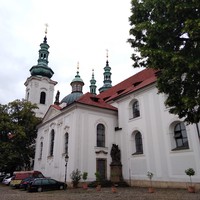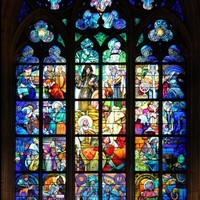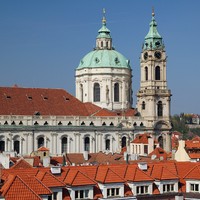Breadcrumbs navigation
III. Alphonse Mucha – the greatest Czech Art Nouveau painter
Walking route: Strahov Monastery complex: Basilica of the Assumption of the Virgin Mary, Strahov vicarage – Cathedral of Sts Vitus, Wenceslas and Adalbert – Thun Palace – St Nicholas Town Bell Tower – "Mucha: The Family Collection" exhibition in the Waldstein Riding School
Strahov Monastery Complex
Today’s walk in the footsteps of Alphonse Mucha begins near Pohořelec tram stop (Tram 22) in the Strahov Monastery. This ancient place, with its unmistakable charming atmosphere featured in Mucha’s life on several occasions. The Basilica of the Assumption of the Virgin Mary, a three-nave Romanesque building in essence, acquired its present appearance through a Baroque adaptation. For Alphonse Mucha it became one of his first great sources of inspiration, due to its main nave decorations by J. W. Neunherzt; a cycle of frescoes with Marian motifs on the vault; and on the walls frescoes with scenes from the life of St Norbert. Marie Muchová recalls: ‘Strahov remained a dearly loved memory for him, and even in Paris he told me of his moments of fervour, sitting engrossed by the lovely music as his eyes surveyed the beauty of painted vaulting, bringing out his longing to create equally beautiful imagery to glorify God.’ (source: Mucha Foundation). In 1906, Mucha’s wedding with Miss Marie Chytilová, his dear wife, took place in this church.

The second building connected with Mucha here is the Strahov vicarage. There Mucha spent several nights with the family of the Strahov organist Vollberger, the father of Mucha’s music teacher in Ivančice. This happened in 1878, when the young Mucha went to Prague to find out whether he had been admitted to the Academy of Fine Arts. At that time, he was emphatically rejected, and strongly advised to seek another vocation.
Then go down the steps to Pohořelec and down Loretánská street to Hradčanské square, where enter the Prague Castle complex and through the Second Courtyard you will reach the Cathedral of Sts Vitus, Wenceslas and Adalbert.
The Cathedral of Sts Vitus, Wenceslas and Adalbert
The history of this cathedral dates back to the first third of the 10th century, when Prince Wenceslas received the relic of St Vitus’ shoulder-bone from the Saxon Emperor, Henry the Fowler. Whereas Wenceslas had the rotunda of St Vitus built, Prince Spytihněv II erected a larger basilica on the site of the rotunda, and in its place in 1344 Charles IV and his father founded a cathedral. It served as the seat of the Archbishop of Prague, and was used for the coronations of rulers as well as their last resting place, and as the treasury of the crown jewels. However, the cathedral was not completed for several centuries, and today is comprised of two parts: the eastern part with the choir, chapels and great bell-tower dates from the 14th-15th centuries; the western part with the transverse nave, triple-nave and twin-spire frontage was added only in the 2nd half of the 19th century and at the beginning of the 20th. It was during the finishing work on the cathedral that Alphonse Mucha was asked by the Czech bank Slavia to decorate one stained glass window. The window was finally set in place in the northern nave of the cathedral in 1931. The central panel presents St Wenceslas with his grandmother St Ludmila and scenes from the life of the Slavic missionary saints, Cyril and Methodius. The image of the goddess Slavia, emblematic of the bank, is near the figure of Christ.
Duly enchanted by the placing and colours of Mucha’s stained glass, you can make your way back to the First Courtyard of the Castle, from which you can view of the city. Slowly go down the New Castle steps. Down below, another site closely connected with the life of the famous painter awaits you.
Thunovská 25
The Renaissance Palace of the Lords of Hradec  (also called the Slavatovský, Kolovratský or Thunovský palace) which took shape through progressive modifications of three burned-out houses in the 2nd half of the 16th century and was then rebuilt in the Baroque style, has its former frontage facing the Castle Steps, dominating their lower right side. On the façade of the palace is a bronze memorial plaque with a relief portrait commemorating the fact that Alphonse Mucha and his family lived here between 1911 and 1924. ‘Meanwhile my grandmother managed to find a big apartment for all of us. It was in the Lesser Town at 25 Thunovská street, on the second floor of the historic Thun Palace. … The apartment had five rooms all in a row. All the windows face south, with a beautiful view of the whole of Prague, Petřín and the magical rooftops of the Lesser Town.’ (source: Mucha Foundation, cit. Jaroslava Muchová).
(also called the Slavatovský, Kolovratský or Thunovský palace) which took shape through progressive modifications of three burned-out houses in the 2nd half of the 16th century and was then rebuilt in the Baroque style, has its former frontage facing the Castle Steps, dominating their lower right side. On the façade of the palace is a bronze memorial plaque with a relief portrait commemorating the fact that Alphonse Mucha and his family lived here between 1911 and 1924. ‘Meanwhile my grandmother managed to find a big apartment for all of us. It was in the Lesser Town at 25 Thunovská street, on the second floor of the historic Thun Palace. … The apartment had five rooms all in a row. All the windows face south, with a beautiful view of the whole of Prague, Petřín and the magical rooftops of the Lesser Town.’ (source: Mucha Foundation, cit. Jaroslava Muchová).
St Nicholas Bell Tower
The last stop on our walk through Hradčany and the Lesser Town on the trail of Alphonse Mucha is the St Nicholas Bell Tower. The tower, bell tower/watchtower adjacent to the church of St Nicholas was completed in 1755 by Anselmo Lurago. The tower has always been owned by the municipality, not the Church, and so we can also find a house number above its entrance portal, something quite unusual for a church building. The last watchman, whose task was to ring the bell during a fire and to show from the gallery the direction of the blaze by hanging a red streamer (at night using a lantern) moved away only in 1891. Subsequently, the painter Jan Vochoč, who was a very close friend of Alphonse Mucha, lived here. They even shared a studio in Paris for some time, and when Vochoč married Magdalena Kozáková in France, Mucha was his best man.
Before the end of this fine walk, take a tour of the tower, for a second-to-none view of the Lesser Town. From there, head to the Waldstein Riding School, where you can see the exhibition "Mucha: The Family Collection".
Route map
1. Strahov Monastery
2. Strahov vicarage (Pohořelec 23)
3. The Cathedral of Sts Vitus, Wenceslas and Adalbert
4. Palace of the Lords of Hradec (Thunovská 25)
5. St Nicholas Bell Tower
6. Waldstein Riding School – "Mucha: The Family Collection" exhibition



